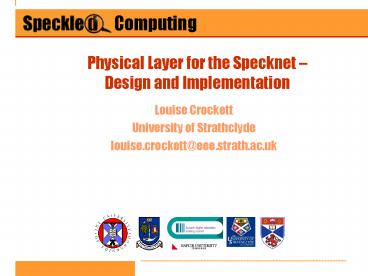Physical Layer for the Specknet Design and Implementation - PowerPoint PPT Presentation
1 / 17
Title:
Physical Layer for the Specknet Design and Implementation
Description:
Oscilloscope probe. Speckled Computing. Simulation results ... Oscilloscope. Speckled Computing ... An oscilloscope was used to probe the outputs of the DAC ... – PowerPoint PPT presentation
Number of Views:113
Avg rating:3.0/5.0
Title: Physical Layer for the Specknet Design and Implementation
1
Physical Layer for the Specknet Design and
Implementation
- Louise Crockett
- University of Strathclyde
- louise.crockett_at_eee.strath.ac.uk
2
Summary
- Context
- Transmitter
- Design Flow
- Simulation, Implementation and Testing
- Further Developments
- Conclusions
3
Physical Layer
Network Layers
Physical Layer DSP
RF Section
- Zigbee chosen as demonstration platform
- Development of prototype
- Gained design experience
- Resolved some practical problems
- Ultimate Physical Layer design may be simpler
than Zigbee
4
Context of Physical Layer
- Digital signal processing of data for
transmission, and data received - Simple protocol chosen for initial implementation
- 802.15.4 (Zigbee)
- Zigbee specifies
- Maximum data rate 250kb/s
- Half Sine pulse shaping
- Provides a basis for development
Higher Layers
Physical Layer
RF transmit / receive
5
Development system aims
- To design and implement a prototype physical
layer on FPGA - To interface with RF section
- To test performance and hardware requirements,
and improve and optimise where possible - To aid in creating a channel model for further
development - To create IP blocks which can be integrated with
MAC and network layers onto a single FPGA
Air interface
DAC
RF
DAC
RF
FPGA
FPGA
Transmit side
Receive side
6
Transmitter detail
- Data rates shown are for Zigbee may be reduced
in proportion
250 kb/s
Transmit Filter I Phase
Binary data
Bit to symbol mapping
1 Mchip/s
Transmit Filter Q Phase
b3
b2
b1
b0
I phase
62.5 kbaud
Symbol to chip mapping
Offset QPSK mapping
Q phase
1 Mchip/s
2 Mchip/s
7
Design Flow
High level simulation
VHDL design entry
Test vectors
Simulation
Synthesis
RTL Netlist
Place and Route
User Constraints File
Reports, Floorplan etc.
Download to FPGA
Oscilloscope probe
8
Simulation results
- Active HDL simulator used to verify output
9
Synthesis
- Synplify Pro was used as the synthesis tool
- A netlist is created from the VHDL source
- This is the main input to the Place and Route
stage - It can also be used to visualise the design
10
Implementation
- Xilinx ISE was used to target the Spartan II FPGA
on board the Nallatech Strathnuey development
board - 150,000 gates on User FPGA
- A User Constraints File was created
- Maps output signals to pins
- Applies timing constraints
- Various reports available
- Timing analysis (constraints met)
- Hardware usage ( 5)
- Floorplan showing placement
11
Floorplan
LED outputs
Bit to Symbol
Internal Clock division
Symbol to chip OQPSK modulation
Q Filter
SNDACINF
External Clock division
I Filter
Clock inputs
DAC outputs
12
On-board Testing
- For testing, a wrapper had to be created around
the transmitter entity. Included - Test vectors,
- Formatting of I and Q outputs for DAC
- SNDACINF entity to interface with on-board DAC
- Mapping of selected outputs to on-board LEDs
Test Vectors
Format I
LED array
Format Q
Zigbee Transmitter
SNDACINF
Clock division
DAC
Oscilloscope
13
Test setup
- Nallatechs Fuse software was used to interface
between the computer and FPGA - An oscilloscope was used to probe the outputs of
the DAC - This verified the design and the operation of the
DAC
14
Further Developments I
- Some modifications to the design are necessary
- Migrate from Strathnuey to Xtreme DSP Kit to
allow faster DAC to be used - Several MHz, rather than 400kHz output
- Combine I and Q phases to provide single output
- Requires more sophisticated filtering
- Continue working closely with University of
Glasgow to interface with RF section of design - Evaluation and improvement of pulse shaping stage
- Improved communications between PC and FPGA
15
Further Developments II - Receiver
- Starting from a higher level of abstraction
- SystemView with FXPlib (Fixed Point Library)
- More detailed analysis of effects of short
wordlengths - New challenges
- Synchronisation
- Channel estimation
- Aiming for completion by Christmas 2004
16
Conclusions
- Working Zigbee-based transmitter designed,
implemented and tested on FPGA - Some minor modifications required
- Design allows for experimentation with pulse
shapes, chipping sequences etc. - Next stage receiver!
17
Review
- Transmitter in detail
- Design flow
- Inputs and outputs
- Simulation, implementation and testing
- Simulation and on-chip test results
- Detailed next stages of work
- Experimentation with filters etc.
- Receiver
- Integration with RF






























